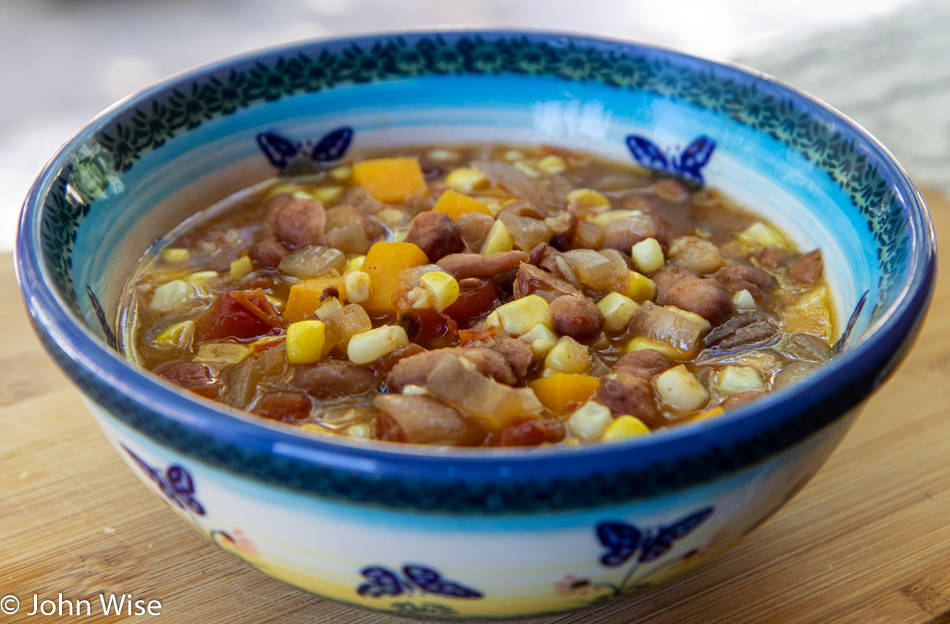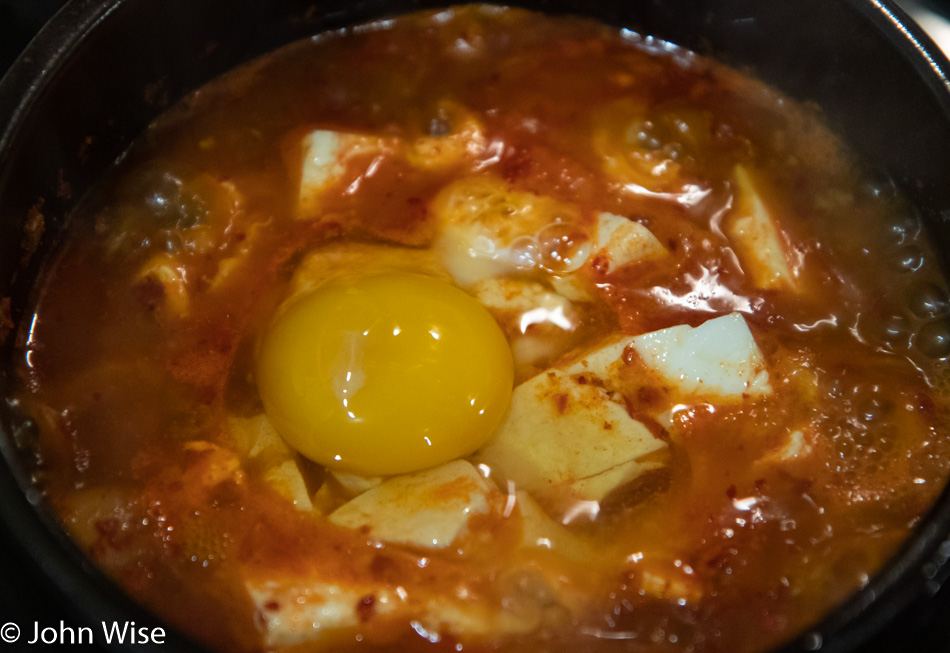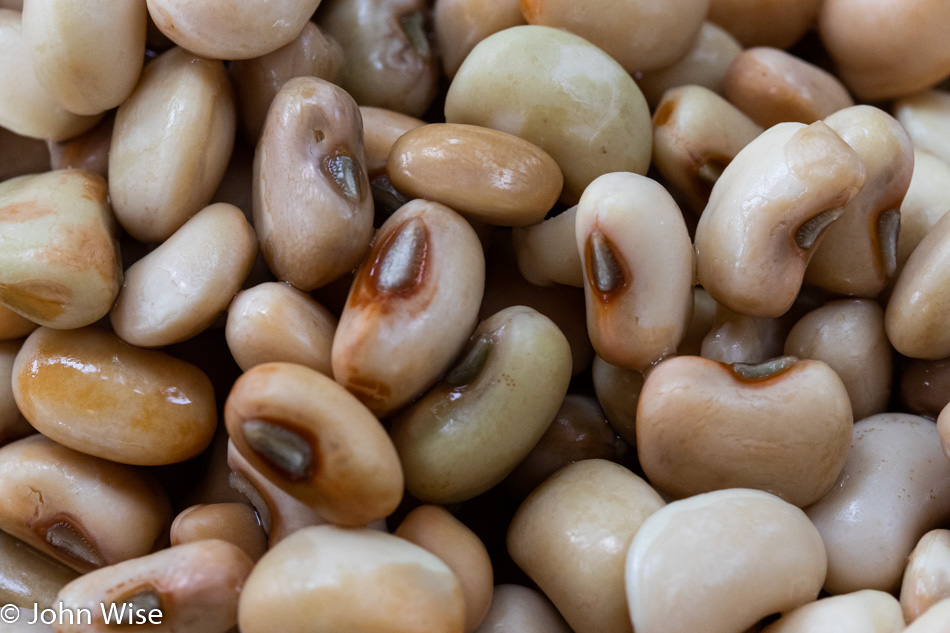
A last-minute change in bean-plan was needed when an emergency use case scenario came up regarding a package of bacon taken from the freezer. Sadly this bean entry cannot just be about beans as extenuating circumstances have intruded into our fantasy travels.
On Thursday, while out shopping at Whole Foods for those scotch bonnet peppers I could not find, I decided I needed something from Costco so I visited our local store. I noticed something strange in that there were no canned veggies available. While that wasn’t out of the ordinary two months ago, things had really started normalizing. Limits on buying meat and eggs had been lifted, toilet paper is always available now, frozen pizza is again on hand, things seemed okay. At first, I didn’t think much of it but then even later in the day, I headed over to another popular grocery store called Fry’s, part of the Kroger chain. Uh oh, the canned veggies and pasta sauce aisles have been ransacked again. I asked a couple of clerks about it and they were curious about what’s triggering hoarding again with one of them wondering out loud why all the Gatorade had been cleaned out.
The best I can tell is that people are talking about another lock-down (not that Caroline and I have left ours yet); I guess others are anticipating food shortages again. This sucks as we were starting to make serious headway into clearing out foodstuffs and making space in our over-packed cabinets. Not anymore, as Thursday into Friday were spent prowling our various suppliers to replenish particular items, starting with our freezer. I removed a hunk of beef to make pot roast, some filets for raclette, and a package of bacon. The bacon by Saturday morning was fully thawed and once it’s opened I want it all used within a week as I feel the flavor starts to weaken at about that time. So instead of our Cuban dish planned for tomorrow, I started a crockpot of black-eyed beans because my recipe calls for bacon.
Back to hoarding. In February and March, I stocked us up well, really well. By the time food runs were happening here in Arizona I was able to act as an observer instead of a competitor. This time I feel I was almost caught off guard so I needed to move fast. At Costco a second time this week, I now picked up a bunch of meat that I could stuff into our very organized freezer. Between two different Fry’s I was able to snag the last 7 bottles of Rao’s Arrabbiata Sauce, some canned corn, and more quinoa and lentil pasta that we just tried for the first time this week and really enjoyed. Silk Soy Milk with the long shelf-life has been gone from our local stores for a couple of months now but I can order it by the case from Walmart. That’s just what I did last night when I ordered another 3 cases for delivery which will bring our stash to a total of 46 quarts, 11.5 gallons, or 44 liters and that should last nearly a year. Through Amazon, I bought more oat groats, sunflower seeds, pumpkin seeds, hemp hearts, and flaxseed to make sure I have enough of those ingredients to compliment the 20 pounds of oatmeal I have atop our cabinets. This is of course for making granola that is eaten for breakfast 5 days a week. I’ll also need to place an order for Walnuts again as we are down to our last four pounds of them, we’re good on almonds with 11 pounds in stock. Good thing I recently bought another 12 pounds of our favorite eucalyptus honey.
Guesstimating to some degree and calculating based on our very accurate inventory of 438 line items I’d say we have a solid 120-day supply of food here at home. When I look into our cabinets there is an element of groaning as it feels like it’ll take forever to go through everything and I dread the idea that any of it should spoil before we use it.
Why am I worried about food scarcity? Our country is failing on a grand scale in managing the COVID-19 pandemic with our very own Governor Doug Ducey indirectly and directly responsible for the death of over 2,000 people in Arizona through his negligence, influenced on some level by being a sycophant of our troubled President. We were the last state to shut down and one of the first to reopen. With 3,000 to 4,000 new cases per day now in Arizona where many survivors will have lifelong breathing and/or mental problems along with the 50-90 a day who are dying combined with the potential social unrest from continuing police killings, a rush to kill teachers and parents by forcing children back to school, and an economy that will at some point have to reckon with the massive unserviceable debts, I become nervous about the chances for violent upheaval. Should we start to see 10,000 new cases a day or more, we could be in a situation where fully half the population of Arizona in the next year will have been infected and at the current mortality rates, we’d see between 73,000 to 140,000 dead just in Arizona. To put this in perspective that’s nearly the equivalent of a 9/11 type event almost every week right here in the state we call home. At that point, I’ll not want to go out for anything at all.
So, the beans. In our ongoing effort to not throw away any of the food we’ve purchased, we pay attention to “use-by” dates and consider the freshness of perishables. To the extent it’s possible, we move around the menu plan and try to see a few weeks out what we’ll be eating. Rice and beans are a simple dish that can be pushed out a few days but the bacon needed to find dishes and so six slices went into the crockpot and three slices became part of lunch as a side to our tomato and avocado salad. Tomorrow morning hopefully the rest of it will be part of our scrambled eggs.





